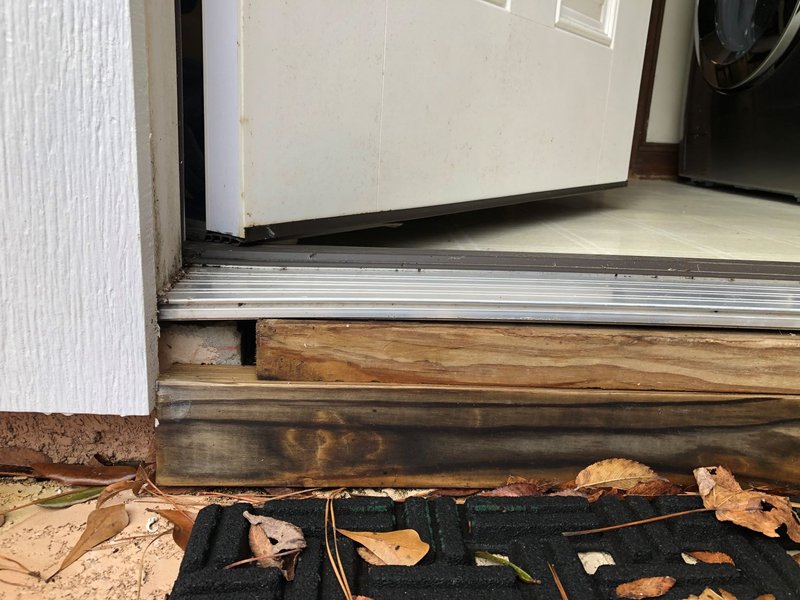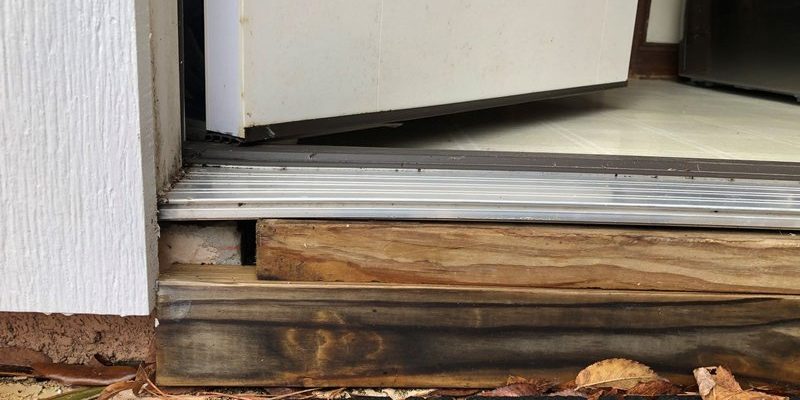
A misaligned threshold is surprisingly common, no matter if you’re dealing with a classic wooden front door or something more modern. Even high-end brands—think Masonite, JELD-WEN, or Therma-Tru—can end up with a threshold that shifts, tilts, or just looks wrong compared to the frame. If you’ve never tackled this before, don’t panic. The fix is almost always in your wheelhouse, no matter how “unhandy” you feel.
Here’s the thing: the threshold is more than just that strip you step over. It seals, supports, and protects. If it’s not lined up with the door frame, you lose energy efficiency, your weatherstripping goes to waste, and the code of your entryway security practically resets itself. Let’s break down what’s going on, why it happens, and—most importantly—how you can troubleshoot and solve it.
Why Thresholds Fall Out of Alignment
Honestly, thresholds have a tough job. Day after day, they take the brunt of weather, shoes, and door slams. Even the best remote-style adjustable thresholds from leading brands can drift out of place. But how? Let me explain some of the biggest culprits behind a threshold that’s not aligned with the door frame.
- Settling foundations: Your house is always moving a little. As it settles, the door frame and floor can shift, pushing the threshold out of sync.
- Temperature and humidity: Wood and composite materials expand and contract with the seasons. Sometimes, this tiny movement is just enough to throw things off.
- Improper installation: If the threshold wasn’t leveled or secured right the first time, it can wiggle loose or tilt over time.
- Wear and tear: Years of people and pets stomping over the threshold can cause screws to loosen or materials to warp.
You might be wondering if it’s always obvious when the threshold isn’t aligned. Sometimes it’s subtle—maybe a tiny draft, a visible gap, or the deadbolt not syncing with the strike plate. Other times, it’s glaring: the threshold looks crooked, or the door simply won’t close. Spotting these signs early makes any troubleshooting easier.
Common Signs Your Threshold Isn’t Lined Up Right
If you’re standing there, remote control in hand, wondering why your smart lock only works half the time, it might not be the code or the battery at fault—it could be the threshold. Here are some dead giveaways your threshold and door frame aren’t playing nicely:
- Gaps or daylight: If you see sunlight peeking under the door, the threshold isn’t sealing correctly.
- Drafts or bugs getting in: A misaligned threshold leaves just enough space for air and critters to slip through.
- Door scraping or sticking: If the bottom of the door drags or gets hung up, it’s often a threshold issue.
- Lopsided appearance: Step back and look. If the threshold looks uneven compared to the frame, you’ve got a problem.
A quick test: close the door, then run your hand along the bottom. Feel any cold spots or bumps? That’s the threshold telling you it needs a little troubleshooting.
Preparing to Fix a Misaligned Threshold
Before you do anything, it’s smart to gather a few tools and figure out what kind of threshold you’re dealing with. Some doors have fancy adjustable thresholds, often paired with modern remote-entry systems. Others are old school: wood, nailed, and painted over a dozen times.
Here’s what you’ll usually need:
- Screwdriver or drill (for tightening or loosening screws)
- Utility knife (to trim old weatherstripping or remove paint buildup)
- Level (for checking the threshold angle)
- Replacement screws, shims, or threshold parts (just in case something’s broken)
If your threshold is part of a code-powered remote system, check if it needs to be reset or if any sensor wiring is blocking the threshold from sitting flat. For most people, though, the process is universal and doesn’t require anything fancy. Still, knowing your door brand (like Therma-Tru or JELD-WEN) can help you track down an exact replacement part if needed.
How to Troubleshoot and Realign a Threshold
Ready to roll up your sleeves? Honestly, most thresholds are held in place by two or three screws and a bit of caulking. Here’s a step-by-step guide to troubleshooting a threshold that’s not aligned with the door frame:
-
1. Remove any old caulk or debris:
Use your utility knife to cut away caulk or paint that might be gluing the threshold down. Sweep away dirt—anything that could stop it from moving freely. -
2. Check the screw positions:
Look for screws on the top of the threshold. Are any loose? Tighten them. If one screw is stripped or missing, replace it. -
3. Adjust or shim:
For adjustable thresholds (especially on newer, code-ready doors), you can often raise or lower the strip with a screwdriver. If it isn’t adjustable, use thin shims under the threshold where it dips. -
4. Test the fit:
Close the door and look for gaps or rubbing. The door should barely graze the threshold—any more, and you’ve gone too far. -
5. Replace or reset weatherstripping:
If the weatherstripping is beat up or out of sync, peel it off and stick new material down. Make sure it creates a solid seal without blocking the door.
If you notice the threshold is warped or cracked, replacing it will save you a lot of future hassle. Sometimes, troubleshooting only buys you a little time.
When to Reset, Sync, or Replace Components
Sometimes, no amount of tightening or adjusting will make a threshold line up. This is especially true for doors with smart remote locks, sensors, or security systems coded into the frame. If something’s not syncing up, the threshold might be blocking a sensor or shifting the angle just enough to mess with a battery-powered keypad.
Here’s how to decide between a quick fix and a replacement:
- If adjustments fix the issue: Great—just check it every few months to make sure it stays put.
- If the threshold is warped or damaged: Replace it. Buy a matching brand component, or choose a universal threshold that fits your existing frame.
- If your remote sensors or smart lock won’t sync or pair: Double-check for any obstructions, then reset the system if your manual recommends it. Sometimes, the threshold needs to be repositioned a fraction of an inch to restore proper function.
Let me be honest: replacing a threshold sounds scary, but for most standard doors, it’s a straightforward swap. Look for a threshold kit that matches your door’s width and brand—JELD-WEN, Therma-Tru, and Masonite all offer replacements that are cut to size, ready to screw in.
Tips for Preventing Future Threshold Problems
You went through all this troubleshooting—how do you keep your threshold from sliding out of sync again? Maintenance is your friend. Here are a few real-world tips I use on my own doors:
-
Check screws and weatherstripping every season.
A quick five-minute inspection in spring and fall can spot loose parts and worn seals early. -
Wipe down and keep it dry.
Water gets under the threshold and can break down wood or rust screws, so dry out puddles right away. -
Don’t slam the door.
It’s tempting, but gentle closes help the threshold and frame last longer. -
If you spot small gaps, deal with them quickly.
Even a sliver of daylight under the door can quickly become a bigger problem if ignored.
If you use a smart lock or remote entry system, keep batteries fresh and occasionally reset the connection to make sure threshold movement hasn’t knocked things off sync. Sometimes, just re-pairing the remote is enough.
Comparing Different Threshold Types: Universal vs. Brand-Specific
Honestly, not all thresholds are created equal. If you discover yours is misaligned and needs more than a little troubleshooting, you’ll face a choice: universal or brand-specific parts.
- Universal thresholds are designed to fit most doors. They’re usually made of aluminum or composite, and you’ll trim them to match your door’s width. The upside? They’re affordable and easy to find. The downside? Sometimes the fit isn’t quite as snug, especially if your frame is an unusual size or shape.
- Brand-specific thresholds (like those from Therma-Tru or Masonite) are precision-made for certain door models. If you have a remote code system or adjustable parts, sticking with your original brand often makes syncing and pairing easier. But they can be pricier, and sometimes you’ll need to special-order the part.
If you’re just looking to reseal and secure your door, a universal threshold usually does the trick. For doors with integrated technology, sensors, or batteries in the frame, a brand-specific replacement helps make sure everything lines up and works as designed.
When to Call a Professional for Threshold Troubleshooting
Most threshold fixes are totally DIY. But there are times when it’s worth calling in someone with more experience—especially if you’ve tried everything, and things still aren’t syncing up.
-
Complex door frames:
If you’re working with an older home or a custom entryway, the frame might be out of square in ways that are tough to reset on your own. -
Integrated remote or security systems:
Some systems have wiring or sensors built into the threshold and frame. If you’re uncomfortable touching this stuff, let a pro handle the troubleshooting. -
Persistent water leaks:
If you keep seeing water inside—even after resetting and resealing—the issue could be with the frame or even the foundation, not just the threshold.
Don’t be shy about reaching out for help. Honestly, one good visit from a pro can save you hours of frustration and keep your door working like new for years.
Final Thoughts on Getting Your Threshold and Door Frame Aligned
Fixing a threshold that’s not aligned with the door frame isn’t rocket science, but it does call for some patience and a little troubleshooting spirit. Whether you’re adjusting screws, syncing up a smart remote, or swapping in a new threshold, taking the time now saves you hassle—and maybe even money—down the road.
Remember: thresholds are small but mighty parts of your entryway. Treat them right, check them often, and don’t ignore the signs when something’s off. A little care goes a long way, and your door (and your toes!) will thank you for it.
